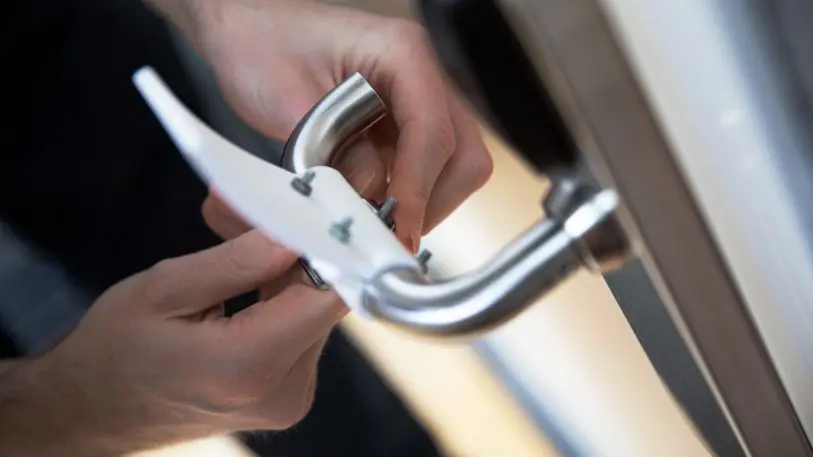Current evidence suggests that the virus that causes COVID-19 can live on surfaces such as stainless steel and plastic for up to three days, meaning it may be possible to infect yourself by touching a contaminated surface such as a door handle and then touching your mouths, nose, or eyes. People often have to enter and exit rooms or buildings, and until more accessible, automatic doors are installed, we can’t simply tell everyone to stop touching doorknobs. A simple, quick solution are these 3D-printable add-ons that can be fitted onto doors in hospitals and businesses, allowing people to open doors hands-free. They could be an easy way to reduce the chance of cross-contamination from coronavirus, and generally keep people’s hands cleaner in the future.
The printable door opener, designed by Belgium-based 3D-printing company Materialise, needs only a few screws to be attached around door handles, allowing a door to be opened with a covered forearm rather than a hand. The idea started with a brainstorming session between the CEO and engineers about what the company could do to help during the coronavirus crisis, says Materialise vice president Bryan Crutchfield. “During that brainstorming session, the idea came up for a way to open doors without using your hands to try to contain the spread of the germs,” he says, “and literally inside of 24 hours they turned around a design, got it on a printer, and printed the first prototype off and tried it out on one of our handles.”

[Image: courtesy Materialise]A 2014 study from the American Society for Microbiology looked at how the contamination of “just a single doorknob or table top” could result in the spread of viruses throughout healthcare facilities, hospitals, and office buildings. A tracer virus was placed on those two commonly touched surfaces at the beginning of the day in a healthcare facility and an office building, and after a few hours, researchers sampled up to 100 fomites, which are surfaces capable of carrying infectious organisms, including light switches, bed rails, push buttons, coffee pot handles, sink tap handles, doorknobs, phones, and computer equipment. Within two to four hours, between 40% to 60% of those surfaces sampled were contaminated.

“It’s an easy quick fix,” Crutchfield says of the hands-free door handle attachments, noting that the design also doesn’t require a lot of testing or rigorous safety production measures like 3D-printed face masks or ventilator valves would to ensure that they work and are as safe as possible. Materialise is in the process of developing designs to 3D-print other devices that can be used in medical settings during the COVID-19 crisis, especially as hospitals face immense shortages, but those designs are awaiting the proper trials before the company makes those files available.
Hands-free door openers aren’t new. These sorts of attachments have long been important for disability accessibility, and many of the responses to the coronavirus pandemic have been things that the disabled community has already been practicing or has previously asked for, from remote learning to work from home accommodations.
For facilities that don’t already have such accessible hands-free door handles in place, a 3D-printable option is an easy add-on, and in a time of crisis like the spread of COVID-19, quick adaptations are especially important. “It’s really interesting to watch the role that 3D printing is going to be able to play to try to accelerate the supply chain,” Crutchfield says. “[Hospitals] are all looking to see how 3D printing can quickly supplement current capacity or alleviate supply chain constraints that they have because of what’s happening.”
Recognize your brand’s excellence by applying to this year’s Brands That Matter Awards before the early-rate deadline, May 3.
